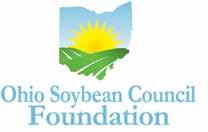
















There are plenty of look-alike seed treatments out there, but don’t let them fool you. With CruiserMaxx® Vibrance® Beans* you get the industry-leading combination of fungicides and insecticide. Nothing else protects your soybeans while boosting root health and yield with the same kind of power. To learn how that helps you win at harvest, talk with your local Syngenta retailer or visit SyngentaUS.com/CMVB.







CAdam Graham
Ohio Soybean Association Chairman Logan County soybean farmer
Biodiesel adds 63 cents per bushel Farmers have benefited
ombines are out in the field and harvest is finally here. There is no contest when it comes to the dedication Ohio soybean farmers have in providing quality soybeans.
As a policy organization, the Ohio Soybean Association (OSA) takes working for Ohio soybean farmers very seriously. As I write this, efforts are underway from the U.S. Environmental Protection Agency to scale back the Renewable Fuel Standard (RFS). Scaling back the RFS poses a threat to 64,000 American workers who rely on biodiesel and the rural communities where soybeans and biodiesel are produced. Biodiesel adds 63 cents to every bushel of Ohio soybeans which has a huge impact on your bottom line. It’s hard to believe, but the total production of biodiesel was 1.9 billion gallons in 2016. In addition, 1 billion gallons of biomassbased diesel were imported in 2016. The EPA proposed volumes of 2.1 billion gallons, including imports, of biomass-based diesel for 2019. Bottom line: this is below the capacity of the biodiesel industry here in the U.S.
OSA and the American Soybean Association submitted comments to the EPA on the proposed volumes, and advocated for a level of at least 2.5 billion gallons for 2019. ASA also encouraged farmers to visit the Soy Action Center to submit comments. If you’d like to be added to the email list and receive action alerts, visit www.soyohio.org and click “Sign up for the OSA Policy Connection e-newsletter” on the right side of the screen.
Also, the annual Ohio Grain Farmers Symposium is scheduled for December 19 at the 4-H center in Columbus located on Ohio State’s campus. The OSA annual meeting is in conjunction with the symposium and we hope to see you there to help us review and develop our policy efforts. You will be receiving a card in the mail with details or you can register at www.ohiograinfarmerssymposium.org.
Hope you had a safe and successful harvest season!
Sincerely,
Adam Graham
Ohio Soybean Association Chairman
Logan County soybean farmer
President
Todd Hesterman, Henry County
First Vice President
Allen Armstrong, Clark County
Vice President
Scott Metzger, Ross County
Treasurer
Ryan Rhoades, Marion County
Secretary
Jennifer Wilson-Oechsle, Van Wert County
Chairman
Adam Graham, Logan County
trustees
Jerry Bambauer, Auglaize County
Bret Davis, Delaware County
Caitlyn Heimerl, Industry Affiliate Ex-Officio
James Heimerl, Licking County
Patrick Knouff, Shelby County
Cindy Parker, Miami County
Tommie Price, Putnam County
Derek Reusser, Holmes County
Ryan Rhoades, Marion County
Jeff Roehm, Highland County
Luke Ryan, Lucas County
Bruce Simmons, Medina County
Jeff Sollars, Fayette County
Andy Stickel, Wood County
Kerrick Wilson, Preble County
American Soybean Association
Board Representatives
Jerry Bambauer
Bret Davis
Jeff Sollars
Staff Credits
Kirk Merritt-Publisher
Jennifer Coleman-Editor
Katie Bauer-Contributing Editor/Staff Writer
Kayla Weaver-Contributing Writer
Donovan Harris-Design Director
Brent Warren-Senior Designer
Barry Falkner-Photo Quality/Proofer
Tony Green-Advertising Production
Ohio Soybean news is published six times a year by the Ohio Soybean Association, 918 Proprietors Rd., Suite A, Worthington, OH 43085. Phone: 614-476-3100. For address corrections contact Ohio Soybean News at 918 Proprietors Rd., Suite A, Worthington, OH 43085.
Web address: www.soyohio.org E-mail: cdeboard@soyohio.org
Comments and statewide news articles should be sent to the above address. Advertising space reservation must be made by the first of the month preceding publication. In consideration of the acceptance of advertisement, the agency and the advertiser must, in respect of the contents of the advertisement, indemnify and save the publisher harmless against any expense arising from claims or actions against the publisher because of the publication of the content of the advertisement.
For Advertising Sales Contact:
Matt Herman- (612) 812-5833
matt.herman@dtn.com




It doesn’t matter what you grow. It doesn’t matter how many acres you farm.
Commodity Classic will help you become an even better farmer.
Commodity Classic is where you can GROW BEYOND in many ways:
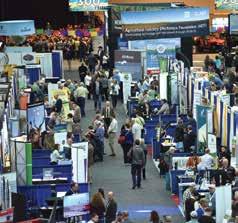










• Powerful educational sessions on key issues, new solutions and the latest innovations
• A huge trade show with the newest technology, products and equipment
• Inspiring speakers and thought-provoking presentations from top ag leaders
• Networking with like-minded farmers from across America
• The chance to enjoy a little well-deserved fun and relaxation
Be in Anaheim for the 2018 Commodity Classic—America’s largest farmer-led, farmer-focused convention and trade show.

ohio Soybean Association (oSA) board members recently traveled to Washington, D.C., to lobby members of Congress on issues related to soybean farmers and agriculture in the State of ohio. They discussed priority issues such as the 2018 Farm Bill, trade expansion, and tax reform.
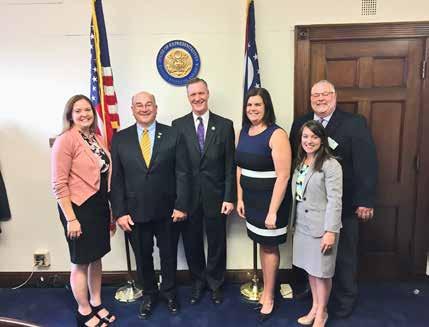

and conversation

An oSA advocacy team visited the office of Congressman Steve Stivers (r-oH 15). From left to right, Jennifer Wilson-oechsle, tommie Price, Congressman Steve Stivers, trish Levering, emilie regula-Hancock, Bret Davis
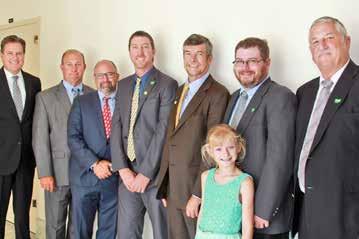
oSA board members caught up with Congressman Mike turner. From left to right, Congressman Mike turner, Allen Armstrong, Scott Metzger, Kerrick Wilson, Jeff Sollars, Jeff roehm (with daughter Mia), Jerry Bambauer.































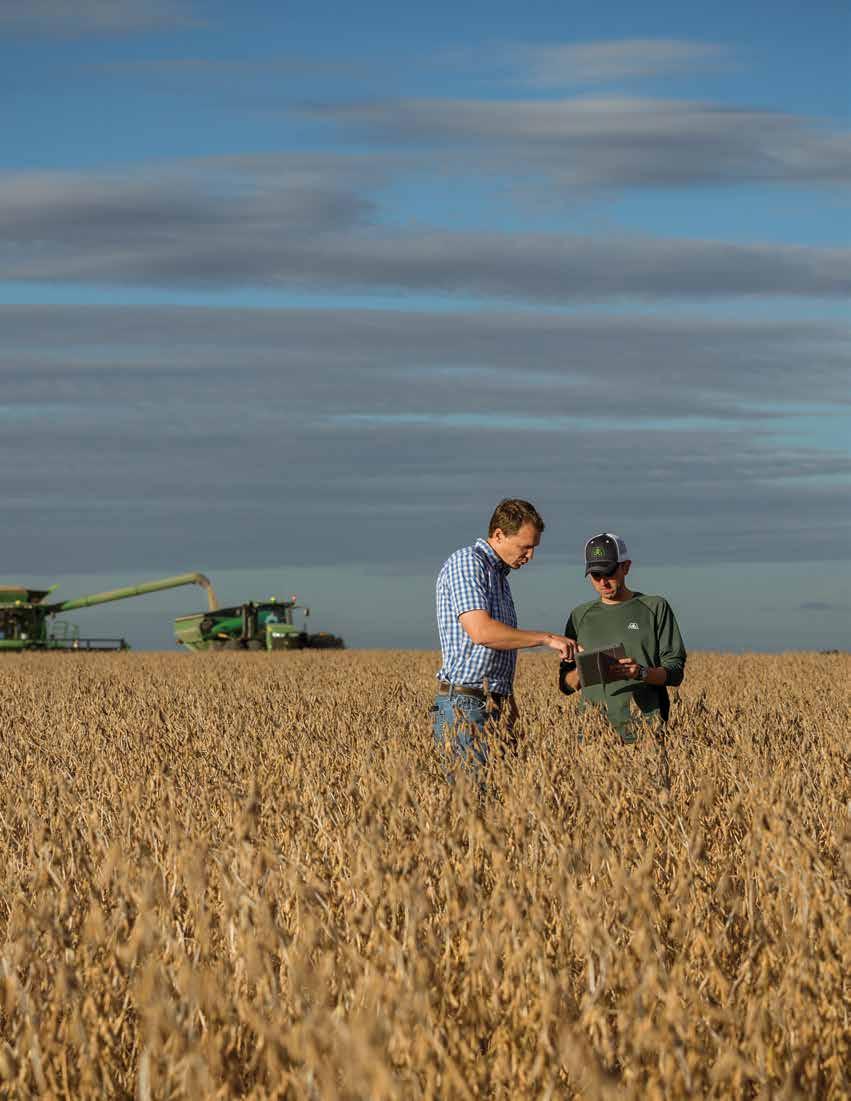
Growing up on his family’s farm in Rockford, Ohio, Jarret O’Neill has a strong foundation in agriculture. Active in his high school’s FFA student organization, he also took on the farm’s straw baling business as a teenager. Now, as he prepares to start his final semester at The Ohio State University, his passion for agriculture has only grown as he looks toward starting a career in the industry.
“We enjoy seeing young people who are passionate about agriculture and dedicated to the future of the industry. Jarret’s experience growing up on a farm and his studies in college will serve him well as he enters his career. The drive of new graduates, like Jarret, to advance current production methods is what keeps our industry progressing,” said Bruce Kettler, Director of Public Relations at Beck’s Hybrids.
Looking to take a hands-on approach to his education, Jarret eagerly took the suggestion from his agricultural education teacher to study Agricultural Systems Management (ASM).
Jarret o’Neill plans to graduate from The ohio State University after fall semester and return to help on his family’s farm while pursuing a career related to his Ag Systems Management major.
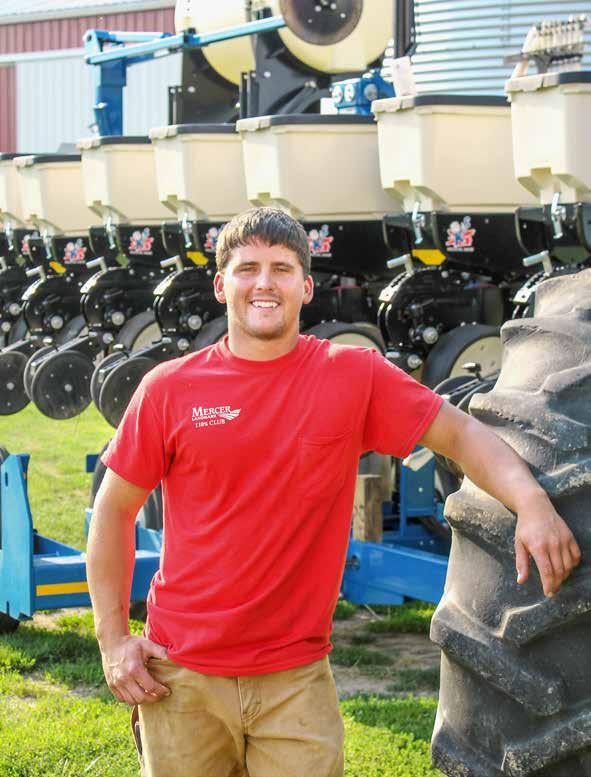
“I wasn’t sure what I wanted to do, but knew I wanted it to be hands-on,” said Jarret. “One of our teachers calls ASM the “swiss army knife” of majors because you get a little bit of every aspect; there’s a lot of variety to keep me interested.”
Armed with a few years of knowledge, Jarret started an agronomy sales internship at Mercer Landmark after his sophomore year of college and has returned the past two summers continuing to grow his skill set and build responsibilities along the way. His position has evolved into operations assistant where he helps with grain handling and tends to the sprayers.
Jarret is looking at obtaining his Commercial Driver’s License with the possibility of returning to Mercer Landmark as a full-time applicator after graduation. He envisions a career as a grain facility operation manager, custom applicator or as part of a precision agriculture specialist team. With his ASM major he would be an asset in many areas and is excited to market himself at Ohio State’s Fall Career Expo.
Outside of the classroom, Jarret works on Ohio State’s landscape crew and is active in ASM Club and Crop and Soils Club where he has helped with Farm Science Review fund-raisers, lawn mower clinics and many community service projects.
“Being involved lets you meet different people, see where they’re from and how much we’re alike, it’s a small world,” said Jarret. “Networking is important because you never know who you might meet that will help you in your career. I have a good relationship with my ASM coordinator, he’s also our club advisor, and having a good relationship with him keeps me up with what’s going on in the industry.”
Jarret also plans to give back once he graduates by staying connected and possibly returning to campus to share his career experiences with the next crew of students. He also plans to help as much as he can on the family farm once his diploma is in hand; and they already have some goals in mind for the future.
On their farm, they grow mainly soybeans along with some wheat, 100 acres of orchard grass / timothy hay and enough corn to satisfy their small cow-calf herd of Hereford cattle Jarret and his father started five years ago. They are working to maximize the efficiency of the land and looking toward adding technology in the future.
“Short term, we want to continue utilizing cover crops and hybrid genetics and put subsoil tile in to help get into the fields faster in the spring since I’ll have a full-time job,” said Jarret. “Putting money back into our ground for now is important, eventually we would like to upgrade more equipment and adopt more precision ag technology. This past spring, we got rid of our grain drill and bought a new planter, that was our first big equipment upgrade and we were very happy with that.”
While Jarret majored in ASM and has a lot of precision ag knowledge, he also believes you can’t add technology unless it pencils out — when it does, he knows the benefits will outweigh the costs in the long run. He admits it can be a risk, like many aspects of farming and the cost of equipment and current land prices is a struggle for young farmers in the industry.
His experience at Mercer Landmark has also given him a better understand-
ing of the importance of seed genetics and having a reliable spray program.
They’ve also began tissue testing their beans when the first trifoliate appears to look at deficiencies in micronutrients. Tissue testing reveals what may be missing and allows them to add nutrients like manganese when they come back to post spray for weeds. Jarret believes tissue testing is often overlooked and is something they added because he saw the benefit from working with the process in his internships.
Readily admitting there is more pressure on today’s farmers to produce more yields and feed an ever-expanding population, Jarret also knows his passion for agriculture became stronger through his years at college. He understands farmers need to be more efficient and conservative with their land, remain optimistic in the face of extreme weather patterns and be more open to discussing issues with the public, but those are challenges he is more than willing to take on.
“Growing up, farming has always been my lifestyle and when you’re away from home you realize just how much you like it,” said Jarret.
“Jarret is a young farmer preparing to launch his career into an industry that is faced with many challenges each day. His optimism and willingness to explore new methods will prove valuable as he becomes part of the next generation to guide our industry,” said Todd Hesterman, OSA president and soybean farmer from Henry County. “We are excited to see where Jarret goes with his career and are excited to recognize him as a Beck’s Young Farm Leader.” u


The 2018 membership campaign of the Ohio Soybean Association (OSA) is now underway. OSA is dedicated to improving the business climate for Ohio soybean producers by promoting effective policies that ensure a growing and profitable soybean industry. OSA relies on its membership base to achieve this goal. Since soybean checkoff dollars cannot be used for lobbying and legislative activities, OSA membership is vital to continued advocacy support.
For $205, a three-year membership includes a seed coupon (valued at $200), a chance to win 50 hours with a Challenger MT500 tractor, soy biodiesel coupons and more. In addition, membership to OSA includes automatic membership to the American Soybean Association and access to their extensive benefits. Most importantly though, an OSA membership helps support legislative and lobbying efforts.
The Student & Young Adult Membership that was introduced last year will be continued in 2018. Student and Young Adult membership includes almost all the same benefits as a regular three-year member and is available to any individual 18-24 years old.
In January, President Trump was sworn into office as the 45th president of the United States. This new administration brings new opportunities and new challenges involving trade expansion and tax reform.
During the most recent state budget, several items were included in House Bill 49 that affect Ohio’s soybean farmers. The two most notable changes were the establishment of the state soybean marketing program and changes to the current agricultural use value (CAUV).
Next year has the potential to have a significant impact on Ohio’s farmers.
2018 Farm Bill is set to be a main topic of discussion among federal legislators. Also, with the upcoming elections, including gubernatorial, statewide and congressional offices throughout the state, the political landscape is on the verge of change in Ohio.
“Being a member of the Ohio Soybean Association is about more than just the great benefits you’ll receive,” said Ryan Rhodes, soybean farmer from Marion County and OSA chairman of the membership communications committee. “It’s about having a voice in the legislative process. Membership is key to the advocacy efforts in representing Ohio’s soybean farmers in Columbus and in Washington, D.C.”
Renew today and start enjoying the benefits of an Ohio Soybean Association membership. One-year, three-year, and lifetime memberships are available. Interested in becoming a member? Call 888-SOYOHIO to join or visit www.soyohio.org/membership. u
take advantage of joining oSA as three-year members receive a coupon worth $200 toward the purchase of soybean seed at any of the participating companies:




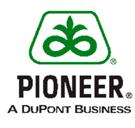



The Ohio Soybean Council (OSC) and soybean checkoff are working with scientists at The Ohio State University and Extension to find new and better ways to manage insects, diseases, weeds, nutrients and water quality all while maintaining your profitability. It can be challenging, however, to stay on top of everything. Soybean Rewards is a program developed by OSC to help keep the flow of information between farmers and researchers moving. To see how, visit soybeanrewards.org.
Brought to you by Ohio soybean farmers and their checkoff.
YOU DON’T HAVE TO DIG DEEP TO SEE HOW SOYBEAN RESEARCH HAS BENEFITTED OHIO FARMERS.
Every two years Ohio’s General Assembly and Governor are called upon to pass a biennial budget bill that funds the operations of the state. The Governor proposes the bill, which is introduced in the Ohio House of Representatives and is considered for several months before being sent to the Senate. This General Assembly’s budget bill is House Bill 49. The bill was signed into law by the Governor on June 30th of this year.
Perhaps more so than any other legislative action, the biennial budget bill reflects the priorities of the state and determines the course of its agencies for the next two years. The budget funds state agencies and social services at both the state and local levels. The bill will include a funding formula for Ohio’s school systems, and it will allocate the
resources needed to fund that formula. It also reflects legislative choices about tax policy, the size and scope of government and the role of government in the economy. Each budget bill is unique and each is influenced by economic and fiscal conditions, which vary from year to year.
In this budget, there were two legislative wins for Ohio’s soybean farmers — the state soybean marketing program and changes to the current agricultural use value (CAUV).
▶ Soybean Marketing Program
• Establishes the Ohio Soybean Marketing Program as a “back-up” to the current national checkoff program. This state-level checkoff would be overseen by the Ohio Department of Agriculture, and would operate under the same procedures and requirements as the existing state checkoff program for small grains, such as wheat.

LAURA LINDSEY RESEARCHER | AGRONOMIST
OHIO
• Prohibits the Ohio Soybean Marketing Program from levying assessments if assessments are being levied under the national soybean checkoff program — so long as the national checkoff is being collected, the state program will not be activated.
▶ Current Agricultural Use value (CAUv)
• Changes the equity rate in the formula to be connected to the USDA farm equity rate, and does not allow it to fall below the debt interest rate.
• Increases holding period assumptions to match the farm economy.
• Places year-round conservation lands at the minimum value.
• Phases in these changes over the next two revaluation cycles in order to address concerns regarding the impact to schools and local governments. u


WITH THE HELP OF YOUR SOYBEAN CHECKOFF DOLLARS.
Meet the researcher whose applied soybean research program improves the bottom line of soybean farmers across Ohio. Dr. Laura Lindsey is an assistant professor of soybean and small grain production in the Department of Horticulture and Crop Science at The Ohio State University. She’s no stranger to the activities of the Ohio Soybean Council (OSC). From identifying yield-limiting factors to supporting graduate students’ quests to further the industry, she enjoys practical science and focuses on research that delivers direct value to our state’s soybean farmers. She is very appreciative of the support of OSC and the soybean checkoff that allows her to offer sound agronomic recommendations.
BROUGHT TO YOU BY OHIO SOYBEAN FARMERS AND THEIR CHECKOFF.




I NDUSTRY-LEADING EXCELLENCE!
An increasing demand for renewable fuels has put biodiesel production on the rise and along with it an increasing abundance of glycogen by-product. Each gallon of biodiesel produced results in a little over one pound of glycerin and according to the United Soybean Board more than 2.9 billion gallons were produced in 2016, meaning there is a glut of glycerin available for use.
interest in utilizing glycerin in engine coolants and other functional fluids.
“Glycerin was actually used in engine cooling systems in early 20th century, but was displaced by ethylene glycol products because they were less expensive at that time,” said Domingo. “What’s changed is that while glycerin in its food grade form is more expensive than ethylene glycol, crude glycerin left over from biodiesel production and the price is very low.”
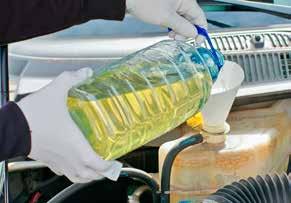
Glycerin, a byproduct of biodiesel production, is showing great potential as a lower cost additive or alternative for engine coolants.
The properties of glycerin make it very versatile, having been used in a wide array of products from makeup to medicines and pet food to engine coolant. Biodiesel production generates crude glycerin with impurities that in its immediate state does not meet most ingredient standards. To filter it for high-grade uses brings an increased cost, but researchers are finding there are old uses for glycerin that are becoming more and more relevant today.
Oscar Domingo has spent his career working in the automotive fluids industry and currently is focusing on new bioglycerin technologies. His recent work with Global Tech Fluids looks at ways to replace petroleum based fluids with renewable resources and has seen a new
While it’s been proven effective in engine coolants, the question that remains is what quality level needs to be achieved for that use.
“If we’re not going to use it as food or medicine, but in cars and trucks, how good does it have to be? It turns out one of the primary issues to use as a food is the fatty acids, which are natural lubricants in an engine, so they are actually a positive,” said Domingo. “The one issue is chloride, leftover from the biodiesel manufacturing process and it’s present in pretty high quantities, but we’ve found it can be removed at a very low cost. While glycerin in its pure form ranges from $16-$20 a gallon, raw glycerin from a biodiesel plant is less than $4 per gallon, so we’re dealing with a very different cost structure.”
The cost structure is what makes glycerin an attractive ingredient for engine coolants as is has the potential to cut the retail cost by half or more. Domingo also recalls Volkswagen’s effort in recent years to use excess bio glycerin in Germany by implementing a coolant with a blend of 20% glycerin which changed the properties of the product so little it could be swapped out and still meet all requirements within the manufacturers allowed variances. The only change was labeling their American product as a radiator additive instead of antifreeze according to product definitions. Extensive research
has also been published by the Cummins engine company, specializing in large diesel engines, which resulted in their corporate coolant specifications (CES 14603) to allow for 100% glycerin engine coolant.
Seeing that much acceptance of glycerin among manufacturers Global Tech Fluids is looking at how to market those glycerin-based products in automotive coolants and beyond.
“What Global Tech Fluids is doing is looking at what other petroleum based fluids glycerin could replace,” said Domingo. “And that’s where the interest has come in investigating and looking at new options.”
Glycerin’s non-toxic biodegradable properties make it ideal for applications in oceanic work, agriculture processes or roadwork where petroleum fluid spills are harmful and difficult to clean up. It is also a fraction of the cost of non-toxic fluids currently being used in sensitive operations such as underground mining. The US military would also benefit from environmentally safe fluids where they may currently have the potential for toxic messes.
In agriculture farmers could receive fringe benefits with a technology that could make it possible for them to purchase one glycerin product for their farm or shop that would have multiple uses simply depending on how much water is added.
With all of the potential uses and benefits, the Ohio Soybean Council (OSC), United Soybean Board and numerous other organizations have been extremely cooperative and supportive of the efforts to bring glycerin into main stream uses.
“Anytime we can find a new way to use soybeans, or in this case the byproduct of a soy-based fuel, it is a win for farmers,” said Terry McClure, soybean farmer from Paulding County who also serves as chairman of OSC. u
Soy Stats 2016
HARVESTED 4,840,000 acres
RANKED 6TH BEST YIELD PER ACRE OF SOYBEANS IN THE NATION, 2.4 bushels above the national average of 52.1 6TH
PRODUCED MORE THAN 263 million bushels OF SOYBEANS THAT YIELDED AN AVERAGE OF 54.5 bushels per acre
RANKED 7th in soybean production ACROSS THE UNITED STATES
unitedsoybean.org
soyohio.org
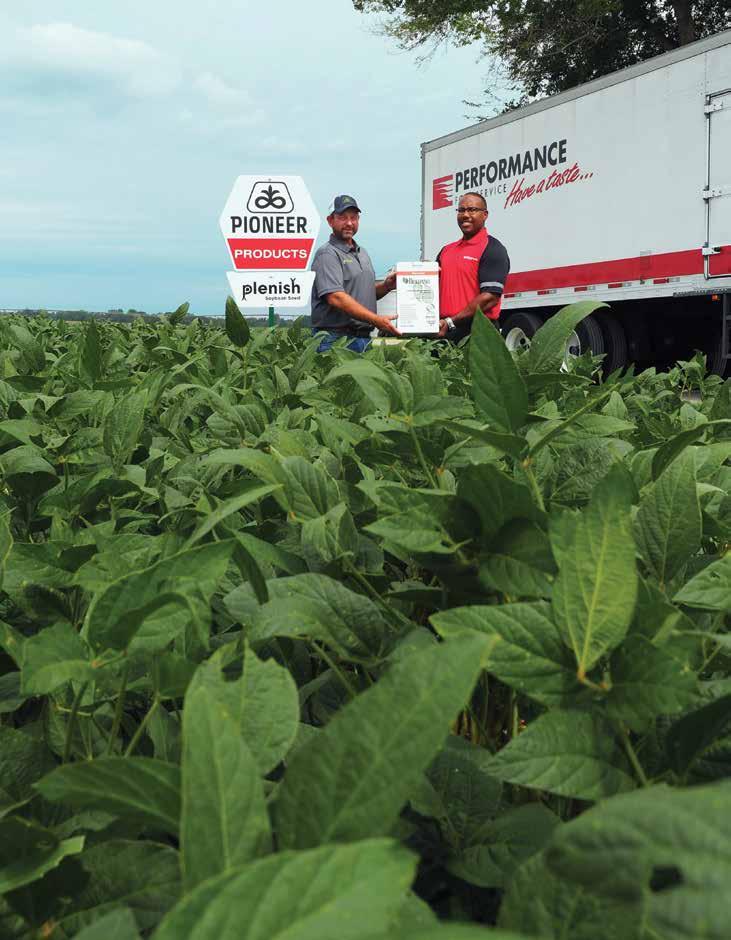
“The Clear Choice”
Brilliance® High Performance Soybean Clear Fry Oil made from Pioneer® brand Plenish® high oleic soybeans that are farmed raised in the U.S.A.
U. S. soybean farmers want a soybean with strong agronomics, high-yielding genetics and key defensive traits.
Today’s culinarians want a fryer oil with a healthier oil profile and increased fry life without compromising flavor. That oil is found in Brilliance® High Performance Soybean Clear Fry Oil.
• 0g trans fat
• The highest amount of heart-healthy monounsaturated fat*
• 20% less saturated fat.**
• Increased heat stability for high-temperature and extended-use applications
• 2–3 times longer fry life
• Significant reduction in polymer buildup on frying equipment reduces maintenance and labor costs for the operator.
PFS Code # 533067
*Compared to all commercially available soy oils. **When compared to commodity soy. Plenish® is a registered trademark of DuPont® Pioneer®. DuPont® Pioneer® is the world’s leading developer and supplier of advanced plant genetics providing high-quality seeds to farmers around the world.

Corporate Headquarters: Richmond, Virginia
NYSE: PFGC COMMUNICATIONS@PFGC.COM

Our roots go back to 1885 as a wholesaler in Richmond, Va. that grew into Pocahontas Foods. We continued to grow and evolve through the mid -1980’s when our leaders had a vision for a new company that would bring together a network of distributors with the corporate support to become an industry giant. Performance Food Group was born in 1987. Today we have three divisions – Performance Foodservice, Vistar and PFG Customized with over 12,000 associates nationwide, 82 distribution locations servicing customers coast to coast, distributing over 125,000 national and proprietary-branded food and food related products to over 150,000 customer locations.
Performance Food Group’s broadline foodservice division, Performance Foodservice, the nation’s third largest foodservice distributor, maintains a unique relationship with a variety of local customers, including independent restaurants and hotels, healthcare facilities, schools, and quick -service eateries
PFG Customized meets the unique needs of some of America’s most recognized national chain restaurants including Cracker Barrel, TGI Friday’s, Outback Steakhouse and Red Lobster.
Vistar is the nation’s leading provider of candy, snacks, beverages, and other convenience and frozen foods. For more than four decades, Vistar has served customers spanning vending and coffee service distributors, theaters, big box retail stores, concessions, and the hospitality industry.
Exclusively from Performance Foodservice, Brilliance® Premium Oils provide the exceptional ability to enhance the natural flavors of menu items fried in oil, providing brilliant results for all cooking needs

Performance Foodservice is the first foodservice distributor to market a private branded seed -specific high oleic soybean oil. May 2017 to-market date.


Hoards of fans decked out in scarlet and gray flooded Ohio State’s campus Sept. 9 as the Ohio State Buckeyes took on the Oklahoma Sooners in their home opener, and one lucky Ohioan reaped the rewards of the Get Grilling, Ohio “Sear the Sooners Ultimate Tailgate Sweepstakes.”
With 20 of his closest friends and family, Jeff Hendricks, from Sycamore, Ohio, savored a catered, pre-game tailgate hosted by the sweepstakes’ sponsor, the Ohio Soybean Council and soybean checkoff, before the big game. The sweepstakes prize package included two tickets to the game; a Weber grill; Yeti cooler; other Ohio State tailgating essentials; and various cuts of meat and food items donated by the Ohio Pork Council, Ohio Beef Council, Ohio Poultry Association, and Ohio Sheep and Wool Program.
Hendricks, a lifelong Buckeyes fan who grew up on a farm raising hogs and beef cattle and involved in 4-H and FFA, was shocked he was selected the winner of the sweepstakes at random.
“I couldn’t believe it because I thought it was just one of those fake contests you
Congratulations to Jeff Hendricks (Sycamore, ohio), the winner of this year’s Get Grilling, ohio “Sear the Sooners Ultimate tailgate Sweepstakes”! Jeff enjoyed a catered, pre-game tailgate for 20 before the ohio State vs. oklahoma game as well as two tickets to the game.
see on Facebook all the time,” he said. “When the Weber grill that was part of the prize package arrived on my doorstep, I knew the whole thing was real.”
“We’re going to have an Ohio State cookout or at least two,” Hendricks said of the Ohio State tailgating gear and food items he won.
The Sear the Sooners Ultimate Tailgate featured beef brisket, pulled pork, pulled chicken and shredded lamb to represent all of the commodity groups that are stakeholders in the Get Grilling, Ohio program and to signify the important role Ohio soybean farmers play in moving meat from the farm to the store to the grill year-round — not just during football season — by
providing livestock with the necessary protein to be healthy.
Of the more than 8,100 online and paper entries in the Sear the Sooners Ultimate Tailgate Sweepstakes, 26 percent of the entrants were unaware that a majority of the soybean meal produced in the U.S. is used to feed chickens, pigs, cattle, turkeys, fish and sheep.
The Get Grilling, Ohio program is one of the many ways the Ohio Soybean Council promotes Ohio soybeans. u
Jeff also received a Buckeye tailgating package, including a new Weber grill, yeti cooler, and meat cuts/food items donated by the ohio Pork Council, ohio Beef Council, ohio Poultry Association and the ohio Sheep and Wool program.

Over the summer, the United States Soybean Export Council (USSEC) hosted trade delegates from China, who represent more than 10 companies, at the U.S. Soy Global Trade Exchange. They opened the event by signing more than $1.5 billion worth of contracts for U.S. soybeans on top of the more than $5 billion in contracts signed by additional Chinese delegates at a separate USSEC event a month before for 460 million bushels of soybeans from U.S. farmers.
The deals total more than $1 billion above similar contracts signed last year for a near-record amount showing a high level of satisfaction with the quality and predictability of U.S. soybeans and once again solidifying China’s hold as the number one customer for U.S. soy — accounting for more than one of every four rows of soybeans grown.
“The Chinese trade delegation did a lot more than sign purchase agreements on this visit to the U.S.,” said Jim Miller, USSEC chairman. “As our guests, they also toured U.S. soybean farms. This experience afforded buyers the rare opportunity to meet their suppliers firsthand and see sustainable practices up close.”
The tours — hosted by USSEC, along with support from the United Soybean Board (USB), American Soybean Association (ASA), and Iowa Soybean Association (ISA) — focused on sustainability, composition and reliability, which are key factors for China’s continued business with the U.S. soybean industry.
“U.S. soybean farmers can feel confident in the long-term, global demand that exists for the products they grow,” said Miller. “U.S. soybean farmers have done an exceptional job of rising to meet the demands of their global customers, from sustainability to compositional quality. This commitment shows our global customers are taking notice.”
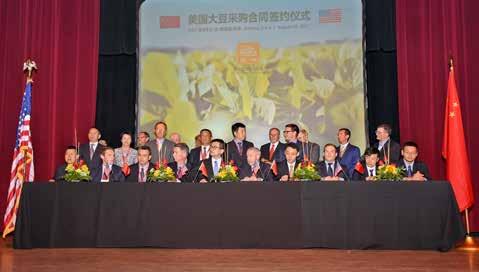
Being a consistent high-quality protein source makes U.S. soybeans a preferred foundation for swine, poultry and aquaculture feedstocks.
“We buy U.S. soybeans because they are sustainable and backed by reliable support,” says Chinese delegation member Jeffrey Zu, who participated in the signing ceremony.
The Chinese trade delegation was led by Bian Zhenhu, president of the China Chamber of Commerce for Import and Export of Foodstuffs, Native Produce and Animal Byproducts (CFNA).
“The U.S. Soy industry has a rich, 35-year history working with Chinese industries,” says Xiaoping Zhang, USSEC Country Director–China. “The event, and the participation of Bian Zhenhu and the CFNA, symbolizes the value of U.S. soybean farmers’ 2017 crop, before it’s even harvested — and is evidence of the enhanced trade agreements between the two countries.”
To celebrate the 35-year anniversary, just before fall, leaders from USSEC and ASA along with state representatives and staff from qualified state soybean boards traveled to China to celebrate the long-standing partnership. Ohio
Chinese trade delegates and U.S. representatives opened the 2017 U.S. Soy Global trade exchange, hosted by the U.S. Soy export Council & Midwest Shippers Association, by signing contracts for more U.S. Soy.
was represented by Bill Bayliss — Ohio Soybean Council board member from Logan County.
China’s growing middle class continues to consume more protein. In turn, growth in their swine and aquaculture industries make them not only the number one consumer of U.S. soybeans, but consumers of more than 60 percent of worldwide soybean exports. u

After an intensive search by a farmer-led team, the United Soybean Board (USB) has named Polly Ruhland as the new chief executive officer (CEO) effective November 1, 2017.
“Polly exceeded all of the attributes for what we as a board were looking for in a new CEO to lead us into the future,” said John Motter, USB chair and soybean farmer from Jenera, Ohio who also serves on the Ohio Soybean Council Board of Directors.
“Polly brings a platform of experience and expertise that parallels the opportunities and challenges facing the soy industry — building demand in domestic and global markets, creating consensus throughout the commodity supply chain, solidifying partnerships with national and state organizations and being an industry catalyst. I am confident that under her leadership, the soy checkoff will accelerate our vision of advancing Innovation Beyond the Bushel,” he added.
Ruhland has provided executive management expertise to the agriculture community for many years. She brings an extensive background in agricultural non-profit management, strategic planning, communications and regulatory compliance to her position serving the directors of USB and the larger soybean community.
She currently serves as CEO at Cattlemen’s Beef Promotion & Research Board. She graduated from Colorado State University with a Master’s Degree in Agriculture and University of Colorado with a Bachelor of Arts in English and Communications. She also did post-graduate work at the PhD level in agriculture and rural sociology with an emphasis on grower decision making in cooperative structures.
She has served as the chairman of the Commodity CEO Roundtable, a group of CEOs in research, promotion, and marketing programs. She is an Eisenhower Fellow, a certified mediator, and holds a professional certificate in the Freedom of Information and Privacy Acts.
In accepting the position, Ruhland said, “USB’s innovation and agriculture industry leadership attracted me to this opportunity. I am looking forward to working alongside farmer leaders and organizational partners to take USB into a bright future.”
USB remains focused on improving farmer profit opportunities through continuous improvement in
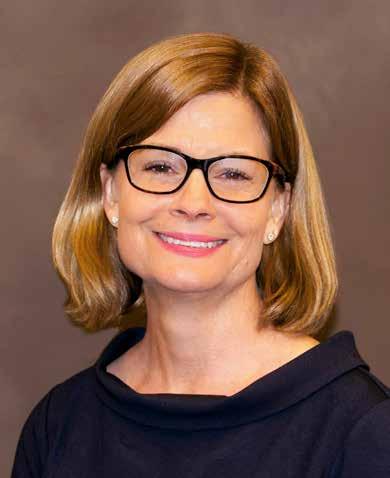
“Polly brings a platform of experience and expertise that parallels the opportunities and challenges facing the soy industry.”
- John Motter
meal, oil and sustainability by leveraging checkoff resources through strategic partnerships.
John Becherer, current USB CEO, served USB for the last 23 years and positioned the checkoff for even greater successes in the future. John will work with USB to support the transition and the incoming CEO until his retirement at the end of the year.
Julie Kanak and her team based at the Chicago office of Diversified Search, a global executive search firm, assisted USB and its farmer-leader team in the recruitment of Polly Ruhland as CEO. u
In business, success is all about the ceaseless quest to develop advantages over competitors.
Goodyear secured its latest competitive advantage with soybean oil, which helped its new Assurance® WeatherReady™ tire achieve excellent performance in dry, wet and winter conditions for true all-season performance.
Over the past six years, the checkoff worked with Goodyear to develop soy-based technology that would add performance to road tires. Goodyear harnessed this new technology to reach the aggressive level of traction it was looking for in the Assurance WeatherReady tire.
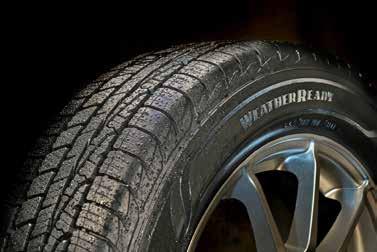
This marks a huge win for the soy industry, which supports research with industrial partners such as Goodyear to innovate, develop new uses and reach new customers with soybean oil.
“The checkoff was established to bring profit back to farmers,” said United Soybean Board farmerleader Larry Marek. “Our win with the WeatherReady tire is the latest example of how farmers’ investments are working for them through the checkoff.”
The checkoff hosts technical meetings to share innovative ideas with leading manufacturers to help them bring more sustainable, better performing products to market.
“Goodyear and the soybean checkoff share something special: a commitment to innovation,” said John Motter, United Soybean Board chair and soybean farmer from Jenera, Ohio who also serves on the Ohio Soybean Council. “When we started working with them more than six years ago, it was just an idea, a way to build demand for soybean oil. Now, we have a tire that shows what soy can do on the road.”
Goodyear had been evaluating soybean oil as an ingredient in compound formulations for some time. When Goodyear learned about Ford Motor Company’s success experimenting with soy-based rubber at one of these meetings in 2011, it decided to expand those efforts.
“Sustainability was a factor that led us to evaluate soybean oil as a material,” said Bob Woloszynek, lead engineer in Goodyear’s global material science organization. “But for an ingredient to make it into a product, it has to deliver true performance.”
In their early research, Goodyear scientists and engineers evaluated how soybean oil might behave in product applications. They looked at traits such as compatibility with other tire materials, curing attributes, thermal stability and mixing capability with rubber polymers.
“We saw some pretty promising results initially just by adding the soybean oil without modification into a compound formulation,” Woloszynek said.
They discovered that soybean oil could improve tire flexibility at low temperatures. This helps keep the rubber pliable in cold weather and
improves traction in rain and snow simultaneously.
“One of the things that makes soybean oil unique is its ability to help provide traction performance in both wet and winter conditions,” said Woloszynek. “We were able to break the trade-off between true wet performance and true winter performance and achieve both simultaneously, which is a significant challenge.”
Goodyear also found that soybean oil mixes more easily with rubber compounds used to make tires, leading to reduced energy consumption, therefore improving the manufacturing efficiency.
“With such a complex tire build, this was a joint effort between many groups,” said Lauren Brace, a Goodyear compound developer. “It was exciting to explore and expand our toolbox.”
The iterative process resulted in a soy-based tire that performs exceedingly well in all seasons and conditions. Soybean oil shined at each stage of the process, bringing new capabilities to Goodyear’s tire technology and supporting its commitment to innovation that leads to consumer benefits.
“I’m thrilled that the technology is now being put to use to bring value to Goodyear and its customers,” said Woloszynek. “In the end, soybean oil was one of the technologies enabling us to meet a challenging performance goal, and that’s something the entire team worked toward throughout the process. The support we received from the checkoff also played a significant role in the success of this project.” u

High oleic soybeans give soybean farmers more marketing options than ever before. While commodity soybeans wil l continue to supply current markets, high oleic soybeans produce an oil with high heat stability to attract additional food and industrial markets. High oleic soybeans only require a few extra handling steps with the benefit of a processor-paid incentive. Whether you grow commodity beans, high oleic beans or both, you’re playing a vital role in growing the value of U.S. soy.



Value-Added Oil
HANDLING
GROWING EXISTING MARKETS
DELIVERY
PROCESSING MARKETS
Identity Preserved 1
Processor-Paid Incentive 2


GROWING EXISTING AND NEW MARKETS
High oleic can set the U.S. soy industr y apar t from the competition. To realize the demand that’s out there, farmers need to show the food industr y that they can provide an abundant, consistent supply of local ly sourced high oleic oil: 18 mil lion planted acres by 2023.

$44,000 in scholarships ARE AVAILABLE FOR undergraduate and graduate students studying agriculture or a related field.
BIOLOGY • biochemistry • bioengineering • agricultural communications molecular biology • food science • biotechnology • CHEMISTRY
AGRICULTURAL EDUCATION • biofuels • environmental science CROP SCIENCE • bioenergy • ENGINEERING • agricultural business
UNDERGRADUATE
Scholarships include:
SIX $3,000 Ohio Soybean Council Foundation Scholarships
ONE $3,000 Robinson W. Joslin Scholarship
One $3,000 FLM Harvest Excellence in Communications Scholarship
One $5,000 Bhima Vijayendran Scholarship
GRADUATE STUDENT Scholarships include:
THREE $5,000 Ohio Soybean Council Foundation Scholarships
Apply by January 12, 2018 at soyohio.org/scholarship
Questions?
Contact Katie Bauer at kbauer@soyohio.org
